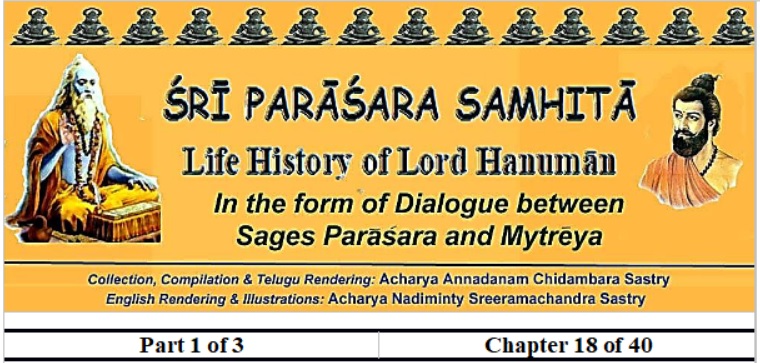
18th Chapter (AşţhādaśaPaţalah)
“Post Bath and Daily Ritual Procedure”
(Snānasandhyānantaravidhi)
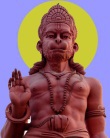
श्लोक:
चित्रासने समासीन: पद्मासनविधानत:
उदड्खप्ड़्खो वा पूजयेद्धनुमत्प्रभुम्।। 1
Parāśara:
(Always perform under the guidance of a Guru)
Sitting & Seating
‘Lord Hanumān has to be worshipped sitting in padma (lotus) posture facing East or North on a seat of tiger skin, ruby studded carpet, deer skin or any other bright spread. (mat, cloth, wooden plank) (1)
प्राणानायम्य विधिवद्गायत्रीमन्त्रपूर्वकम्
भूशुंद्दि च प्रकुर्वीत रंगवल्लीं न्यसेद्बुध:।। 2
Performing purification of Earth (bhoosuddhi) breath control (prāņāyāma) as stipulated, reciting Gāyatrīmahā (great Gāyatrī) mantra, draw a rangavalli (geometerical line pictures) pattern (usually with rice flour, turmeric powder etc). (2)
सिंहासनं न्यसेत्तत्र वस्त्रालंकारसंयुतम्
चक्रं कर्णिकयायुक्तं अष्टकोणं प्रकल्पयेत्।। 3
Establish a cloth decorated throne there. Draw there the eight-cornered (aştakōņa) amulet with a central round spot (karņika). (3)
मन्त्रराजं सप्रणवं भावयेदष्टवर्णकम्
अमर्कमण्डलायाथ उपर्युपरि सर्वदा।। 4
Feel the eight-lettered best of mantras including the Ōmm (praņava). Say ‘ammarkamandalāya’ (to the Sun’s brilliance), then (4)
चं चन्द्रमण्डलायेति ध्यात्वाध्यात्वा नमाम्यहम्
रमग्निमण्डलायेति संपूज्येव प्रयत्नत:।। 5
Saying ‘cam candramandalāya’ (to the Moon’s brilliance), again and again meditating ‘rammagnimandalāya’ (to the Fire God’s brilliance), on purpose bowing with folded hands (namah), (5)
कमलंचिंतयेत्तत्र दलाष्टकसमन्वितम्
विमलोत्कर्षिणीज्ञानक्रियायोगाढथ् इत्यपि।। 6
Imagine there the eight-petal lotus (NOTE: Alternate word in original is, ‘kalāştaka’ = eitht arts), saying vimalā (pure), utkarşiņī (eminence), gñyāanam (knowledge), kriya (action), yōgādhya (equanimity), (6)
नमाम्यहिंसासत्याभ्यां ईशानायै दलांतरे
अनुग्रहायै नम: कुर्यात् ओं नमो भगवतेपि च
विष्णवे चेति तत्रैव सर्वभूतात्मने पि च।। 7
Ahimsa (non-violence), satya (truth) and Eeāana (Śiva) named eight overlords imagined in the eight petals are bowed to with folded hands. There itself saying ‘anugrahāyainamh’ (bow to the obliger) ‘Ōmmnamōbhagavtēnamh’ (bow to the great Lord) ‘sarvabootātmanēnamh’ (bow to the dweller in all beings), (7)
पुनरोंकारमुच्चार्य योगपीठात्मने पि च
पुन:प्रणवमुच्चार्य मंत्रपीठात्मने नम:
इति ध्यात्वा तत: कुर्यादावाहनमुपक्रमम्।। 8
Uttering Ōmm again, uttering ‘yōgapeeţhātmanē’ (seat and soul of Yōga) and again ‘Ōmm mantra peeţhātmanē’ (seat and soul of themantra), one has to meditate and then the orderely invitation programme (āvahanōpakrama) has to be performed. (8)
पूर्वादीनि च चत्वारि द्वाराणि परिकल्पयेत्
द्वारपालान्यथापूर्वं पूजयेत्तत्र संयुत:।। 9
Starting from East, four gates have to be composed in the mind and, like as discussed already, guards of these doors are to be worshipped with devotion. (9)
संतप्तहेमवपुषं ब्रह्माविष्ण्वीशसंयुतम्
हनूमत्परमात्मानं ध्यायेद्देवं जगत्पतिम्।। 10
Hanumdāvāhaņa
Meditate on Lord Hanumān shining like burnished gold, having godly form, protector of the worlds and blessed with the essence (amşa) of Brahma, Vişņuand Śiva. (10)
उपरिस्वामिनं कृत्वा आवाहित इतीरयेत्
स्थापितस्सन्निधिश्चैव सन्निरुद्धो भवेत्यपि।। 11
Then the Lord has to be established and invoked – by saying ‘avāhitōbhava’ (be invited), ‘sthāpitōbhava’ (be seated), ‘sanniruddhōbhava’ (be manifested, around us), (11)
सम्मुखोभवतस्या गे्र अवकुण्ठोभवेत्यपि
प्रसन्नोभव चेत्यग्रे अमृतोभव सम्मुखे।। 12
‘Sammukhobhava’ (be face to face, with me), ‘avakunthōbhava’ (be spread around), ‘prasannōbhava’ (be pleasant), so saying (12)
प्रसीदेति प्रसीदेति स्वागतं समुदीरयेत्
चतुष्र्वा वरणेष्वेवं कीर्तयेद्देवता: क्रमात्।। 13
To be welcomed by saying ‘praseedōbhava, praseedōbhava’ (be pleased, be pleased). Then worshipping of the gods has to be carried out in four routines. (13)
षडन्यासससंज्ञं च प्रथमावरणं विदु:
द्वितीयावरणं चापि विदुर्जांबवते नम:।। 14
In the first the şadañganyasa (touching six body parts) has to be performed. In the second routine tell ‘Jāmbavatēnamah’ (bow to Jāmbavan, dear aide of the Lord). (14)
तृतीयावरणं चैव लोकपालाख्यया युतम्
तुरीयावरणं चैव तदायुधपथार्चयेत्।। 15
Know that the third routine is concerned with the rulers of the world (lōkapālakas). In the fourth round His weapons are to be worshipped. (15)
षडड्गा वरणस्यैवं प्रकारो यं बुधैस्मृत:।। 16
The methodology of the şadañganyasa was told by scholars as follows. (16)
ओमंजनासुतायेति नम इत्युक्तिपूर्वकम्
हृदये देवमित्युक्त्वा वाहयामीति संवदेत्।। 17
Şadañga Nyasa
With ‘ĀmmAñjanāsutāyanamh’ (bow to the sun of Añjana) say ‘hŗdayēdēvamāvāhayāmi’ (I invite the lord into the heart). (17)
ईं रुद्रमूर्तय इति नम इत्युक्तिपूर्वकम्
शिरसि देवमित्युक्त्वा वाहयामीति संवदेत्।। 18
With ‘EemmRudramūrtayēnamh’ (bow to the very form of Rudra/Śiva) say ‘śirasidēvamāvāhayāmi’ (I invite the lord into the head). (18)
ऊं वायुपुत्रायेत्युक्त्वा नम इत्युक्तिपूर्वकम्
शिखायैदेवेमित्युक्त्वा वाहयामीति संवदेत्।। 19
With ‘ŪmmVāyuputāyanamh’ (bow to the sun of Wind God) say ‘śikhayaidēvamāvāhayāmi’ (I invite the lord onto the knot of hair on the head). (19)
ऐमन्निगर्भकायेति नम इत्युक्तिपूर्वकम्
कवचे देवमित्युक्त्वा वाहयामीति संवदेत्।। 20
With ‘AimmAnigarbhāyanamh’ (bow to the Fire God) say ‘kavacayadēvamāvāhayāmi’ (I invite as the protective amulet). (20)
औं राममुख्यदूताय नम इत्युक्तिपूर्वकम्
नेत्रत्रयाय देवं चा वाहयामीति संवदेत्।। 21
With ‘AummRāmamukhyadutāyanamh’ (bow to the chief emissary of Rāma) say ‘nētratrayāyadēvamāvāhayāmi’ (I invite the lord into the three eyes; including the 3rd vision). (21)
अ: ब्रह्मस्त्रनिवारणाय नम इत्युक्तिपूर्वकम्
अस्त्राय देवमित्युक्त्वा वाहयामीति संवदेत्।। 22
With ‘Aha Brahmāstranivāraņāyanamh’ (bow to the neutralizer of Brahmāstramissile) say ‘astrāyadēvamāvāhayāmi’ (I invite the lord into the weapons). (22)
एवं षडड्गविन्यासं प्रथमावरणे विदु:।। 23
So was described by the scholars the performance of the first routine (pradhamāvaraņa) of the şadañganyasa. (23)
जांबवान्विनतो नील: पवनो गन्धमादन:
सुषेणमैन्दद्विविदा द्वितीयावरणे विदु:।। 24
Other Routines
Jāmbavan, Vinata, Nīla, Pavana, Gandhamādana, Suşhēņa, Mainda,Divida (all dear aides of Hanumān) and others are in the second routine (divītiyāvaraņa). (24)
इन्द्राग्निश्च यमश्चैव नै तिर्वरुणस्तथा
वायु: कुबेर ईशान्यास्तृतीयावरणे विदु:।। 25
Indra, Agni, Yama, Niŗrti, Varuņa, Vāyu, Kubēra, Eeśāna (Śiva) (all nature gods) are in the third routine (tŗuttiyāvaraņa). (25)
वज्रशक्तिश्च दण्डश्च खड्ग: पाशो ध्वजस्तथा
गदा त्रिशूलकंचेति तुरीयावरणे विदु:।। 26
Vajrāyudha, saktyāyudha, dandāyudha, khadga, pāsa, dhwaja, gada, triśūla (all weapons – āyudha) are in the fourth routine (caturdhāvaraņa). (26)
एतान्यावरणाानि कुर्यात्पूजाविधिर्हरे:
न कुर्यादन्यकाले तु आवरणानि कदाचन।। 27
These are Lord Hanumān’sāvaraņas (worship routines). These have to be followed. These āvaraņas are never to be performed on other occasions. (27)
धाता विधाता प्राग्द्वारे जयविजयौ च दक्षिणे
चण्डप्रचण्डौ पश्चिम्यां उत्तरद्वारसंस्थितौ
बलप्रबलनामानौ द्वारपालौ वितीरितौ।। 28
Dhāta (creator) and Vidhāta (decider) at the eastern gate, Jaya and Vijaya (door keepers of heaven) at the southern gate, Canda(fierce one) and Pracanda (very fierce one) at the western gate and Bala (strong one) and Prabala (very strong one at the northern gate) are said to be the dwārapālas (gate gaurds). (28)
ऐश्वर्या नैश्वयौं तौ उपपालकसंज्ञकौ
प्राकाररक्षकावेतौ प्रपूज्यौ देवसन्निधौ।। 29
Aiśwarya (wealthy one) and Anaiśwarya (one without wealth) named secondary keepers are the defenders of the boundary wall (prākāraraksşka). They too desrve being worshipped in the presence of the Lord. (29)
तत: पुरुषसूक्तं च कीर्तयेदवितन्द्रित:
षोडशहुपचारांश्च कुर्याद्योगी हनूमत:।। 30
Then, with utmost care, the puruşasūkta (Ŗgvēda invocation to the male form of the Supreme being). The six services (şodasōpacāra) have to be performed for Lord Hanumān with utmost care and equanimity. (30)
सर्वावरणदेवाश्च सायुधास्सपरिच्छदा:
सयोग्यवाहनच्छत्रविंजामरविभूषणा:।।
सोपस्करा नदीमुद्रा सहिता सुखिनोभृशम्
तिष्ठंत्विति समुच्चार्य स्वाहांतं प्रजपेद्गृही। 31
The house holder has to utter ‘tişţhantuswāhā’ (be seated) and worship all those with weapons, those with followers, those with appropriate carriers, umbrellas, fans (made of long natural fiber), variety of ornaments, carrying weighty things, apparently from river areas, very happy ones of the all-pervading (sarvāvaraņa) gods. (31)
सुषेणांगदसुग्रीवा: जाम्बवान्निलसंज्ञिनौ
गवाक्षमैन्दद्विविदोश्शरभो गन्धमादन:।। 32
Suşhēņa, Añgada, Sugrīva, Jāmbavan, Nīla, Gavākşa, Mainda,Divida, Śarabha, Gandhamādana, (32)
गवयश्च प्रहस्तश्च सुशेणनलमामकौ
हनूमत: प्रसादो सर्वे गृह्णन्तु वानरा:।। 33
Gavaya, Prahasta, Suşhēņa, Nalanamed all the monkey worriors have to partake Lord Hanumān’s propitiated food offering (prasāada). (33)
नित्यहोमविधिं कुर्यात् हुवेत्स्मार्ताग्निहोत्रके
पंचद्वादश वा प्रोक्ता आहुतीर्नित्यहोमके।। 34
Routine Fire Sacrifice
Oh!Mytreya! Listen, I am telling the procedure of regular fire sacrifices (nitryahōmavidhi). Offerings (āhuti) to the regular fire sacrifices recommended are five times or twelve times in the fire obtained from smārta (fire from the householder belonging to the system of worshipping five gods). (34)
हव्येन तण्डूलैर्वाथ गोघृतेन विशेषत:
सप्ताक्षरी हनूमत: प्रोच्चरन् प्रत्यहंहुनेत्।। 35
With the offer material (havyadravya) of coocked rice (NOTE: An alternative form given was ‘annēvatandulairvā’ = coocked rice or uncooked rice) or cow ghee, the fire sacrifice has to be performed daily while reciting hanumansaptāksarīmantra. (35)
सकालनियमस्तत्र चोक्ता होमविधानके
कर्मिणस्तु यथाकर्म कर्मणानन्तरं विदु:।। 36
Time restriction was stipulated for this homa procedure. Those performing strictly as per procedure know the infinite activity (anantakarma). (36)
पुरश्चर्याड्गहोमेषु तत्कल्पोक्तदशांशत:
अनेन विधिनासाड्गमाचरेद्यस्तु कर्मत:।। 37
Whoever performs in the ‘repetitive body part fire sacrifices’ (punścaryāñgahōma), as per the given stages (daśa) and sub-stages (anśa), (37)
सयाति परमां सिद्धिं यथाशास्त्रविधानत:
मुतुक्षुरर्चयेस्त्तत्र निर्बन्धो त्र न विद्यते।। 38
Such one will attain the best achievement (siddhi). One desirous of liberation (mokşa) can also perform this as per scripture stipulation. There is no restriction in this. (38)
यदाकदा वा यंत्किंचित्कुर्याच्छक्त्यानुसारत:
तावन्मात्रेण संपूर्णं फलमाप्नोत्यसंशय:।। 39
Even one performing whenever and with whatever devotion, will, undoubtedly, obtain full fruition. (39)
दूर्वारयुग्मं जुहुयादेकं च समिधं तथा
फलपत्रसुमान्येकं चरुमामलकोपमम्। 40
A blade of dūrvā grass (Cenchrusciliaris), a sacred darbha (blade of Desmotachyabipinnata) grass blade, fruits, leaves, flowers, coocked rice the size of an Indian gooseberry are to be offered to the fire. (40)
धारारूपं घृतं दद्यान्मंत्रांगे होमकर्मणि
तर्जनीमध्यमानासु सर्वभिस्तण्डुलान् हुनेत्।। 41
In the fire sacrifice activity, a part of mantra cult, cow ghee has to be poured as a fine stream. Rice has to be offered in it using the knots of the index and middle fingers. (41)
हनूमन्मंत्रमाहात्म्यं केन स्तोतुं हि शक्यते
साकल्ये वा वैकल्ये वा मेरुतुल्यफलं लभेत्।। 42
Who can praise the immense significance of the Hanumanmantra? If the ‘body part fire sacrifice’ (añgahōma) is performed, even with some defects, it will give fruition eaquivalent to the size of Mount Mēru. (42)
तिष्ठन्गच्छन्समासीन: शयालुर्वा स्वपन्नपि
भुंजानो भाषमाणो वा हनुमन्मंत्रमुच्चरेत्।। 43
One should go on reciting Hanumanmantra as per rules while standing, walking, sitting, lying down, sleeping, eating, talking, even while attending nature calls. (43)
न्यूनाधिकाक्षरत्वेन रतिकाले पि वा जपन्
परां सिद्धिमवाप्नोति नात्रकार्याविचारणा।। 44
When recited (only mentally), even with less or more letters, .i.e., wrongly, it will give ideal fruition, undoubtedly. (44)
देवतातरमंत्राणां साड्गत्वेन फलं लभेत्
ईषन्मंत्रस्य वैकल्ये वृथायासो भवेन्नृणाम्।। 45
For other gods and goddesses, one will obtain fruition when performed only as per strict procedure. If some mistake is done in the mantra, it will be a wasteful effort for the seeker. (45)
बहुनात्र किमुक्तेन वचसा मनसा मुने!
ऐहिकामुष्मिकेभ्यो वा हनुमद्भक्तिमान् भवेत्।। 46
Oh! SageMytreya! Why to say in different ways? Fruits of this or the other world’s will accrue to whichever devotee of Hanuma that takes His name in word (vāgrūpēņa) or in mind (manasā). (46)
अनौपाधिकभक्तिस्याद्दैवते यत्र यस्य च
अनायासेन तस्यैव तन्मंत्रस्सिध्यति धु्रवम्।। 47
Achieving fruition of the mantra is easy in those in whom devotion to the Lord comes naturally. (47)
कलशे पि च चक्रे च मुद्रिकान्दर्शयेत्तत:।। 48
Then the eight hand gestures (mudra) have to be exhibited at the holy vessel (kalaśa) and the amulet (yantra). (48)
मन्त्रस्नानं मंत्रसंध्या कर्तव्यं सदनेष्वपि
भूशुद्धिर्भूतशुद्धिश्च मातृके बहिरन्तरे
समस्तमन्त्रजालानां समानं मनुरब्रवीत्।। 49
Ritual bath (mantrasnāna) and daily ritual (sandhyāvandana) mantra has to be performed even in one’s houses. Manu (first man!) stipulated the same bhoosuddhi, bhootasuddhi, bahirmātŗkāandantarmātŗkā procedure. (49)
ऐश्वर्यार्थं चरुं भक्षेत् मधुरत्रयसंयुतम्
शर्करामधुसर्पींषि मधुरत्रयमीरितम्।। 50
For obtaining wealth, the offered hravya including the three sweeteners has to be eaten; sugar, honey and joggery (Indian crude candy) are the three sweeteners. (50)
हनुमन्मंत्रचक्राणां मुद्रिकाष्षोडशस्मृता:
अवराणि च चत्वारि कर्तव्यं न्यासपंचकम्।। 51
For all the Hanumān related amulets (cakra) sixteen hand gestures are told. Four routines and five nyāsas are also to be performed. (51)
उपदिष्टेषु मंत्रेषु प्रथमो मूलमुच्यते
प्राणायामत्रयं कुर्यान्मंत्रस्याद्यंतयो मुने।।
इतरेषांतु मंत्रााणामेकमाद्यंतयोर्मतम्।। 52
Mantra Types &Prāņāyāma
Oh! SageMytreya! Of all the mantras explained, the first one is the base or root mantra. At the beginning and ending parts of the mantra, pranayamas are to be performed thrice. For the other mantras one prāņāyāma is sufficient. (52)
यद्यन्मंत्रं जपेत्तत्र तैस्तै: प्राणान्निरोधयेत्
आद्यन्त्ययोस्सदा कुर्यान्मालामंत्रस्य मूलत:।। 53
Whatever mantra is being recited, the stop-breath (prāņanirōdha) has to be done with the same mantra. Especially, for the string mantra (malāmantra), at the beginning and end añganyāsa, karanyāsa and dhyāna must be performed with the base/root mantra. (53)
अड्गन्यासकरन्यासध्यानानि च पृथक्पृथक्
शुद्धा नमोंता स्वाहांता तर्पणांता जयांतिका:
प्रवृत्तय: पंचधा स्यु: मालासु निखिलास्वपि।।। 54
In case of the seven malāmantras ending with the words śuddha, namah, swāhā, tarpaņa, jaya, five different versions are existing. (54)
शुद्धा संबुद्धिमात्रा स्याज्जपस्तेन विधीयते।। 55
Recitations stipulated only with an address (sambōdhana) are known as pure-ending (śuddhāntāh). (55)
मनसा पूजनं देवपादुकां पूजयामि च
स्वाहेति होमरचना तर्पयामीति तर्पणम्
जयद्वन्द्वसमायोग: स्तुतिरुक्ता तु पंचमी।। 56
The hōma mantra procedure ending with ‘dēvapādukāmpoojayāmi’ (bow to the feet-protectors or footwear of the Lord) is known as ‘namōnta’ (ending with bowing), the one ending with ‘swāhā’ (povided to the Lord through fire – Fire God’s wife Swāhā ) is known as ‘swāhānta’ (ending with havya offering) and the one ending with ‘tarpaayāmi’ (pouring water for the Lord) is known as ‘tarpanānta’ (ending with water pouring) and the fifth one is ‘jayāntā’, i.e., one ending with ‘jayajaya’. (56)
यो लिखेत्प्रवदेद्ध्यायेद्रावयेत्प्रतिपादयेत्
पूजयेत्पुस्तकं धन्य: समत्र्यो मुक्तिमान् भवेत्।। 57
The person who writes, narrates, meditates, imagines, proposes as per scriptures, worships this work (mantragrantha) will attain liberation. (57)
जानूर्वोरंतरेसम्यक्कृत्वा पादतले उभे
ऋजुकायस्समासीन: स्वस्तिकं तत्प्रचक्षते।। 58
ĀsanasforMantras
Sitting by folding the legs in such a manner that the bottom surfaces of the two feet lay between the respective calves and thighs is swastikāsana (sitting in Swatika) posture (58)
अवन्यामात्मन: पाश्र्वे गुल्फौ निक्षिप्य पादयो:
सव्ये दक्षिणगुल्फन्तु दक्षिणे दक्षिणेतरम्
एतच्च स्वस्तिकं प्रोक्तं सर्वपापप्रणाशनम्।। 59
Sitting by folding the legs in such a manner that the heel of the left foot touches ground on the right side and vice versa is also the all sin-removing swastikāsanaposture. (59)
ऊध्र्वोरूपरि विप्रेद्र कृत्वा पादतले उभौ
पद्मासनं भवेदेतत्सर्वेषामपि पूजितम्।। 60
Oh! Best among BrāhminsMytreya! Sitting by folding the legs in such a manner that the bottom of the two feet are seen on both the thighs is the famous padmāsana(lotus posture). (60)
एकपादमथैकस्मिन् विन्यस्योरुणि संस्थितम्
इतरस्मिन्तथाचोरुं वीरासनमुदाहृतम्।। 61
If one foot is kept against one one thigh and the other thigh kept as such, then it is the vīrāsana (worrior posture). (61)
मेड्रवुपरिनिक्षिप्य सम्यग्गुल्फं तथोपरि
गुल्फांतरं तु निक्षिप्य सिद्धिस्सिद्धासनं विदु:
हनुमन्मंत्रविषये आसनानि शुभानि वै।। 62
Sitting with one heel just above the top of penis and the second heel in the first one, results in the siddhāsana (achiever) posture. These āsanas (sitting postures) are auspicious in the worship of Lord Hanumān. (62)
इति श्रीपराशरसंहितायां पव्म्चमुखहनुमन्मंत्रविवरणे श्रीपराशर मैत्रेयसंवादे स्नानसंध्यानन्तरविधिर्नाम अष्टादशपटल:
Thus ends the 18 th Chapter entitled “Post Bath and Daily Ritual Procedure” (Snānasandhyānantaravidhi) ofŚrīParāśaraSamhitā
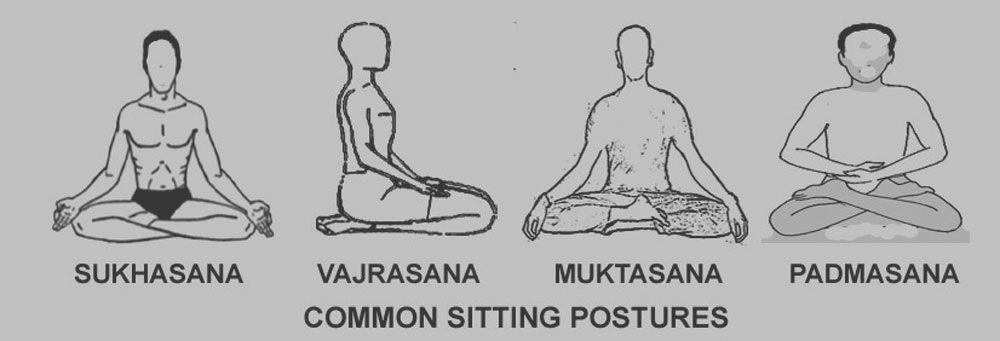
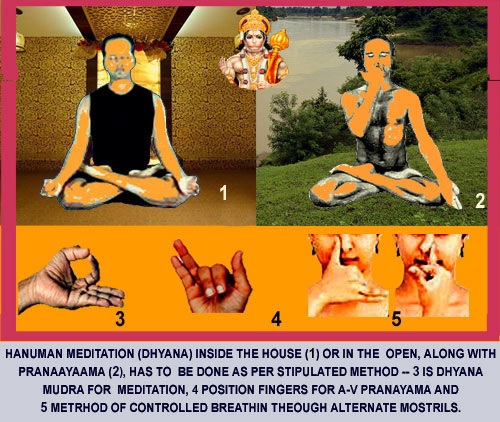
![]()

Click here to visit the Contents of the Part 1.
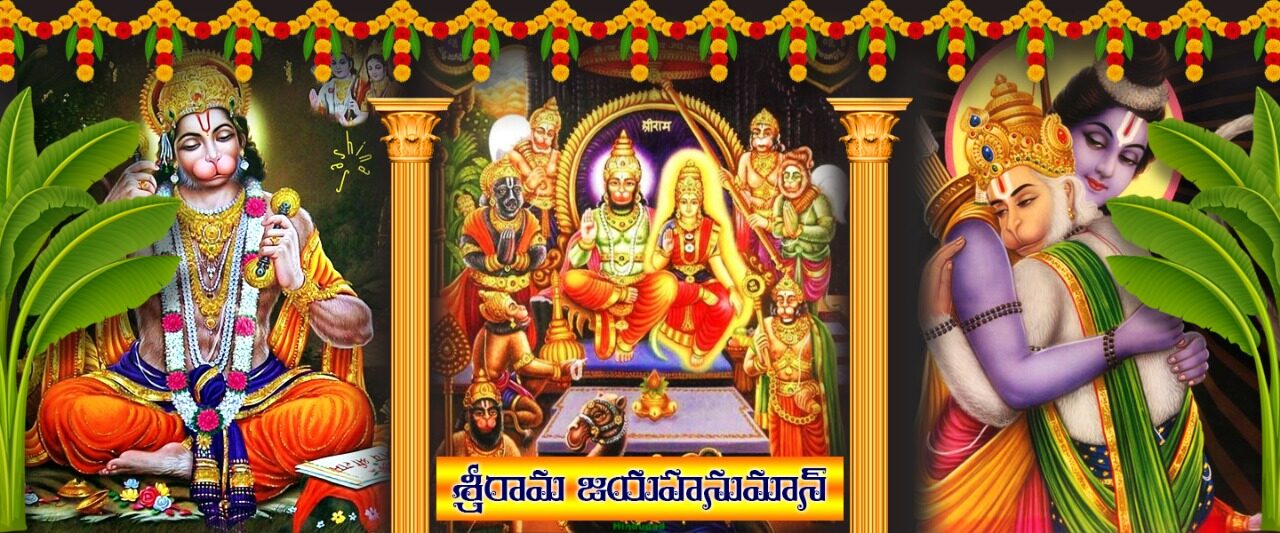
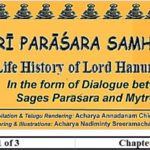

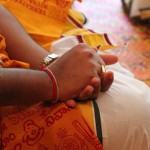


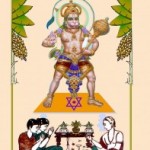
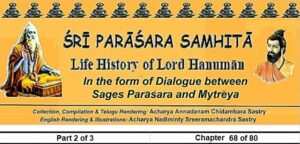
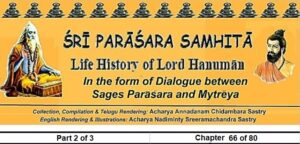
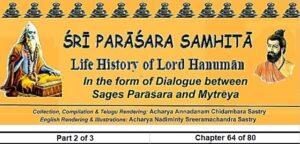
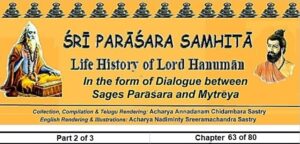
Be First to Comment